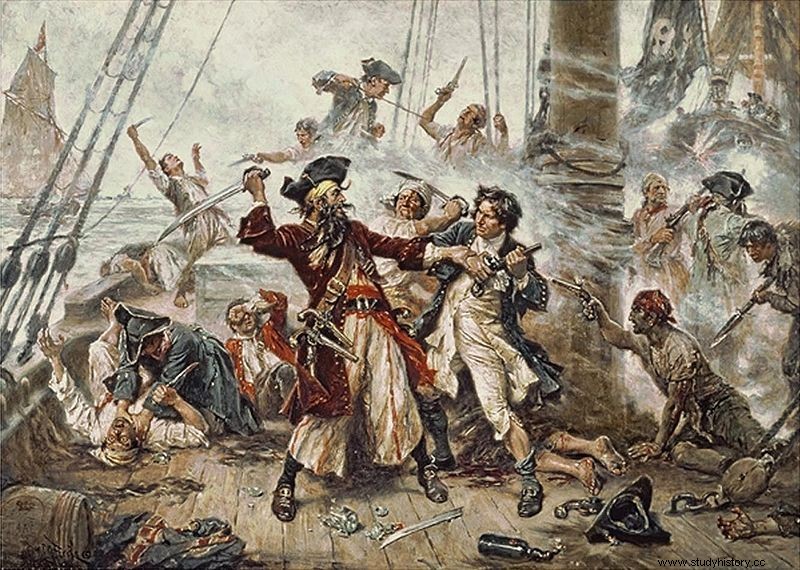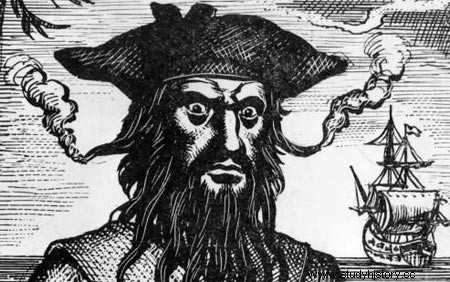A common mistake that is customary to make when talking about the piracy of the sixteenth, seventeenth and eighteenth centuries, is to put in the same bag, for example, Sir Francis Drake , Henry Morgan and Edward Teach Blackbeard . What would the first, a noble marine loyal servant of Queen Elizabeth I of England, have thought, knowing that he was being compared to the third, a bloodthirsty criminal of the sea? Surely he wouldn't have liked it at all. This common mistake —even among historians— stems from the confusion of terms to designate criminal acts at sea, since the terms pirate, corsair, buccaneer and filibuster are usually used almost as synonyms. First of all, we must bear in mind that these four words can only be contextualized at the same time in the maritime history of America, especially the Caribbean, since the piracy of the Mediterranean or the China Sea was governed by other actors. Although pirates and corsairs existed, buccaneers and freebooters were exclusive to Central America. Despite the fact that these men and many of their contemporaries, as well as the acts they committed, are grouped under the great umbrella that is the term piracy -as they are all acts of banditry and pillage on board a ship-, there are differences sufficiently significant between them to be able to distinguish them.

First of all we have the pirates —whose word comes from the Greek word peirates , who is none other than an adventurer of the sea—whose presence in the world is as old as navigation. However, during the 17th and 18th centuries they lived their golden age, freely attacking ships and installations of the Portuguese and Spanish crowns. These attacks, despite the fact that they focused on the possessions of these two European powers, did not have a national meaning behind them, since the pirates, wherever they came from, indifferently attacked any ship that could give them benefits in the form of wealth of all. The clearest examples of pirates were Edward Teach Blackbeard , Calico Jack Rackham and Bartholomew Roberts Black Bart .

Blackbeard
On the other hand, long before their appearance in the Caribbean, the corsairs existed. , whose degree of delinquency was and is controversial, since many considered them criminals and other national heroes. The men and ships that were called corsairs traveled under the protection of a marque letter —word from the Latin cursus , career—, a document in which a king gave them authorization to attack ships and enclaves of enemy powers. In this sense, it was very common, in a Colonial America dominated by Castilians and Portuguese, that the crowns of France, England and Holland, even being allies of some of the former, authorized various ships and captains to attack the possessions of the peninsular powers. . These attacks, although on many occasions they reported economic benefits, their only objective was not to steal, but also to hinder the commercial activities that were carried out in the enemy territories; as well as stopping the transport of wealth to the Old World and, in this way, complicating the maintenance of wars in Europe, for example. They were corsairs men like Sir Francis Drake , Walter Raleigh or Henry Morgan .

Sir Francis Drake
Among the exclusive protagonists of the Caribbean, some were the filibusters . The origin of this word is very confusing, there are authors who defend its origin in the Dutch word vrij buiter —the one who captures the booty freely—, translated into English as free booter and to French as flibustier . For others, however, it comes from the Dutch word vrie boot , which translates into English as fly boat or light craft, describing the type of ships used to commit their attacks. These men, who at first acted freely attacking small ships without straying too far from the coast, were the first to turn piracy into something more than a crime, creating a filibustering society on the coasts of Santo Domingo and Tortuga, called the Brotherhood of the Coast . However, over time, European governments saw a use in the freebooters, and welcomed many to focus their attacks on the enemy territories of their sponsors, becoming a middle ground between the pirate and the corsair, being able to speak of tamed pirates . Surely, one of the best known filibusters was Jean David Nau , better known as François l’Olonnais , which became the terror of the Caribbean for almost twenty years.

François l'Olonnais
Last but not least, let's see who were the buccaneers . These men, whose origins are exclusively Caribbean, were originally hunters of cattle and wild pigs from the islands. Its name comes from the procedure, of indigenous origin, that they used to roast and smoke meat, called boucan . This meat was sold on the coast to the ships that docked there. Being persecuted by the colonial authorities in Santo Domingo, the main buccaneer enclave, many of them abandoned their trade to become pirates, as Gosse said «from slaughtering cattle, they became butchers of men «. Both because of the type of attacks, near the coast, and because of their chronological and geographical proximity, many buccaneers merged with the filibusters, forming the first crews whose sole purpose was acts of piracy, becoming part, also of the Brotherhood of the Coast.
Buccaneers
Even having presented these four styles of piracy, we must never forget that they were not watertight compartments, that is, the most common thing was that men who were once pirates, became corsairs, or vice versa; in the same way that many buccaneers ended up being freebooters, only to later become corsairs. So we could say that there was a high rate of permeability between the different groups of marine bandits. As we have seen, both corsairs, freebooters, buccaneers and pirates, had their moment of glory, however, it was the latter who, over time, remained in the popular imagination. These characters, despite being criminals, ruffians and dangerous, went from being devils to becoming romantic heroes, who although they could steal and kill, did so to defend their lives in freedom, far from the domains of the great European monarchs.
Collaboration of Francesc Marí Company
